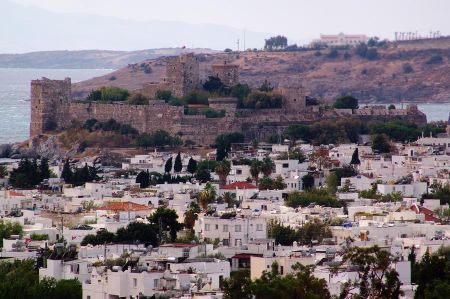A short Bodrum History - formerly called Halicarnassus
Bodrum, ancient Halicarnassus, is famous mainly due to the Mausoleum once located there, a tomb, the Persian satrap of Caria King Mausolus II. erected during his lifetime. The huge mausoleum was considered to be one of the Seven Wonders of the World.
Bodrum has been the cradle of several civilizations. It is known that the region was populated in approximately 3000 B.C. During a long period of time it has been affected badly by countless invasions coming from the direction of the Aegean islands. It was seen as very important to occupy the city to dominate the Aegean and Mediterrenean Seas.
The first settlement in the area was on the rocky little island where today the castle takes place. When the Knights of St. John came to build their fortress, they found the ruins of an older castle which is now known to have been built by the Dorians around 1100 B.C.
The next settlers were the Carians and the Lelegians. They lived on the hills on the Peninsula of Bodrum. It was an important city in the Caria civilization especially, as it was located between Lykia and Ionia.
Bodrum experienced dominance by various civilizations during the whole period of its history - Persians, Macedonians, the Roman Empire and the Byzantines. The Byzantine occupation became a quiet period. However, the city became home to the Crusaders from Rhodes in the Middle Ages. The Byzantines lost their power in the Anatolian region after they were defeated by the Seljuk Ruler Alparslan at Malazgirt.
Rhodian knights had constructed the present Bodrum castle. Sultan Süleyman the Magnificient expelled the knights from Bodrum and conquered it together with Rhodes, and added them to the territory of the Ottoman Empire. The Ottoman Empire developed quickly and became successful during Süleyman´s reign but a long period of internal crisis and decline followed.
Please read as well:
Together with Sponge divers in Bodrum / Turkey
Myndod Gate to Halicarnassus in Bodrum
-
 Castle of Bodrum
Castle of Bodrum
Castle of Bodrum
Castle of Bodrum
-
 Siege of Bodrum
Siege of Bodrum
Siege of Bodrum
Siege of Bodrum
-
 Amphitheater Bodrum
Amphitheater Bodrum
Amphitheater Bodrum
Amphitheater Bodrum
-
 Castle of Bodrum
Castle of Bodrum
Castle of Bodrum
Castle of Bodrum
-
 Herodot
Herodot
Herodot
Herodot
-
 Artemisia
Artemisia
Artemisia
Artemisia
-
 Mausolos
Mausolos
Mausolos
Mausolos
-
 Artemisia & Mausolos
Artemisia & Mausolos
Artemisia & Mausolos
Artemisia & Mausolos
-
 Herodot
Herodot
Herodot
Herodot
-
 Artemisia & Mausolos
Artemisia & Mausolos
Artemisia & Mausolos
Artemisia & Mausolos
-
 Herodot
Herodot
Herodot
Herodot
-
 The Fisherman of Halikarnassus
The Fisherman of Halikarnassus
The Fisherman of Halikarnassus
The Fisherman of Halikarnassus
https://www.alaturka.info/en/turkey-country/aegean/mugla/1606-bodrum-history#sigProId1b79f34f4b

